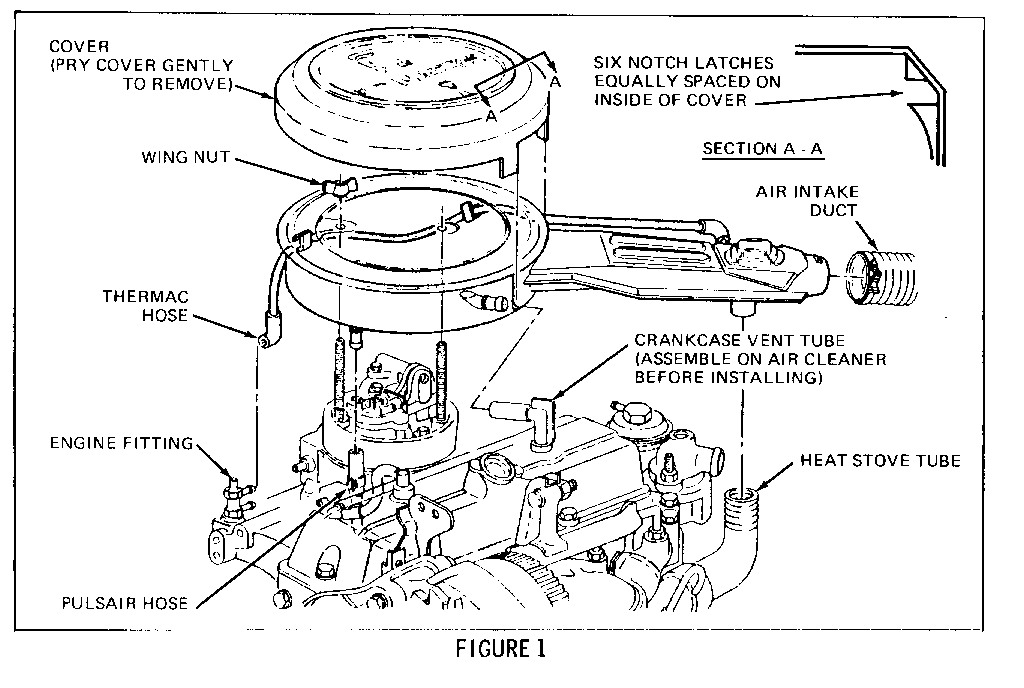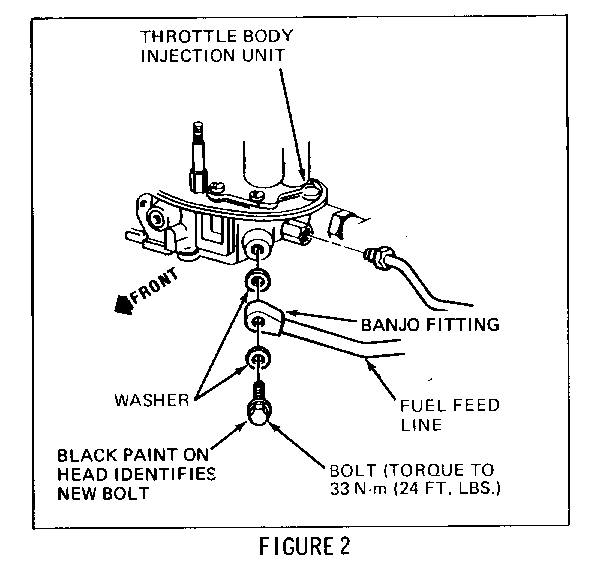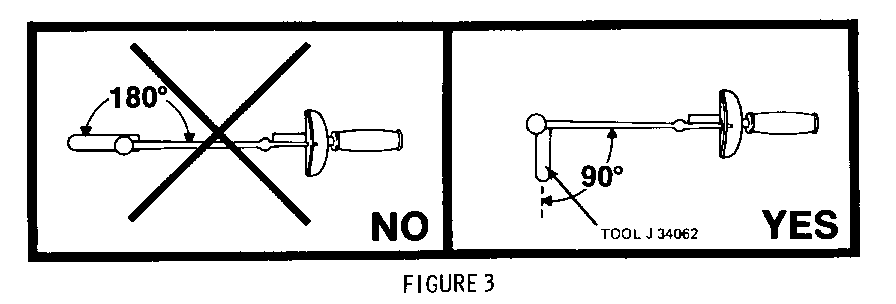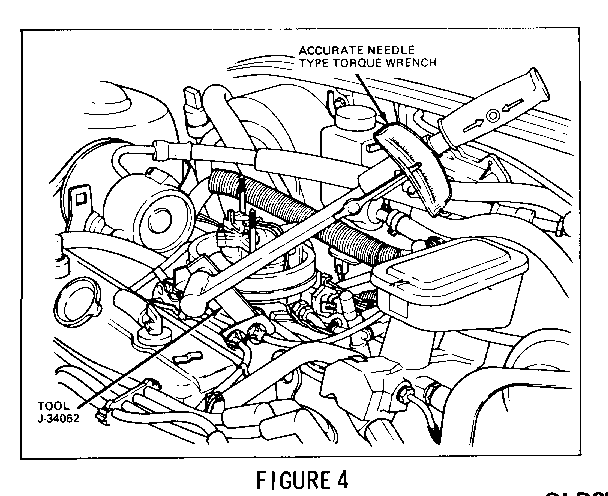CAMPAIGN: FUEL LEAKAGE AT FUEL FEED PIPE CONNECTION

CONDITION
General Motors has determined that a defect which relates to motor vehicle safety exists in certain early production 1983 Oldsmobile Firenza models equipped with 2.0 Liter engines (LQ5). The fuel system in these vehicles may leak at the Throttle Body Injection fuel feed pipe connection. Under certain conditions this could result in an underhood fire. Such a fire could, in time, spread to the passenger compartment and cause burn injuries to occupants remaining in the vehicle.
VEHICLES INVOLVED
Involved are certain early production 1983 Oldsmobile Firenza models equipped with LQ5 (2.0L engines) from the start of Production through the following serial number.
Assembly Plant Serial Number --------------- -------------- Leeds DK301701
Some vehicles within the serial number range listed have had the campaign correction performed in the assembly plant before the vehicle was shipped. These corrected vehicles can be identified by a black painted mark on the head of the banjo fitting bolt that attaches the fuel supply line to the TBI unit.
DEALER ACTION
To reduce the possibility of this occurring on vehicles involved, the fuel feed line "banjo" fitting bolt and two (2) new washers (gaskets) are to be replaced.
Dealers are to perform this recall campaign at no charge to the owner on affected vehicles, regardless of time, mileage or ownership, and are to correct all affected vehicles in dealer new and used car inventory prior to their sale.
Whenever a vehicle subject to this campaign is taken into your new or used car inventory in the future, you should take the steps necessary to be sure the campaign correction has been made before reselling the vehicle.
Dealers are to perform the campaign services on all affected vehicles as they are brought in for any kind of service until all affected vehicles have been corrected.
SERVICE PROCEDURE
CAUTION:
To reduce the risk of fire and personal injury, it is necessary to relieve the fuel system pressure before servicing fuel system components.
a) Remove fuse marked "Fuel Pump" from fuse block in passenger compartment.
b) Crank engine - engine will start and run until fuel supply remaining in fuel lines is consumed. When engine stops engage starter again for 3.0 seconds to assure relief of any remaining pressure.
c) With ignition "OFF", replace "Fuel Pump" fuse.
1. Remove air cleaner cover (plastic) and air cleaner assembly. See Figure 1.
Care should be used when removing air cleaner base so as not to stretch (plastic) thermac vacuum supply line before disconnecting from manifold vacuum tee. Leave crankcase ventilation hose attached to air cleaner and remove from valve cover with air cleaner assembly.
2. Inspect the gold colored bolt which attaches the banjo fitting to the TBI unit, See Figure 2.
If the bolt head has a black stripe or black paint, the campaign correction has been completed, reinstall the air cleaner and air cleaner cover and install campaign correction label, step No. 15.
3. Remove distributor cap and rotor. Do not remove coil wire from coil.
4. Remove fuel supply line banjo fitting bolt from the TBI unit and two (2) nylon sealing washers (inboard and outboard). Care should be taken so that fuel supply line is not deformed. This will ease installation of new parts. Discard bolt and washers. See Figure 2.
5. Install one new lead coated washer (gasket) on a new bolt (black paint on head) and insert into banjo fitting. See Figure 2.
6. Install second lead coated washer between banjo fitting and injector body. See Figure 2.
On a "hot to touch" engine, it may be necessary to pull fuel line towards throttle cable retainer bracket and install gasket over banjo fitting bolt. Do not deform fuel line as misalignment between banjo and TBI seal surface may occur.
7. Thread banjo fitting bolt into injector body. Verify that washers are in the correct position before torquing. Do not lube gaskets or bolt threads.
8. Attach Kent Moore Tool No. J34062 (1983 essential tool being shipped separately) on a pointer readout beam type torque wrench. Do not use a "clicker" or a dial (circular readout) type torque wrench. See Figure 3 and 4.
9. Torque banjo fitting bolt to 33 Nm (24 ft. lbs. or 288 in. lbs.).
NOTICE: It is important that torque be applied at a slow and constant rate. Overtorque may result in bolt failure.
10. Reinstall Rotor and distributor cap.
11. Plug the open vacuum fitting on the inlet manifold vacuum tee.
12. Start engine and check for fuel leaks.
13. Remove vacuum plug.
14. Install air cleaner assembly making sure vacuum supply line, running frm air cleaner retainer clip to thermac temperature switch, is not pinched between air cleaner and TBI isolator unit. See Figure 1.
15. Install campaign correction label as follows: Record the campaign number 83-C-1, dealer code and date on the blank campaign correction label and install on the radiator baffle where it is readily visible.
PARTS INFORMATION
The parts required to complete this campaign will be shipped directly to the dealers who have vehicles to correct, at no charge. Additional parts may be ordered through your zone office. Parts are not to be ordered from WDDGM. Parts are to be retained for disposition by Zone personnel.
WARRANTY CLAIM INFORMATION
All dealers USING the terminal submission system are to submit campaign claims using their terminal. All other dealers are to submit campaign claims using the "yellow stripe" campaign cards. See page 59 of the Oldsmobile Claims Preparation Manual.
Operation No. Operation Labor Hours ------------- ---------- ----------- V1390 Inspect Banjo Bolt Only .2 hr.
V1391 Inspect and replace banjo fitting bolt and (2) washers (gaskets). .3 hr.
A parts credit for 30% of dealer price of the "furnished" parts will be credited to the above "inspect and replace" operation number.
.1 hour for clerical administration will be added to the above operations.




General Motors bulletins are intended for use by professional technicians, not a "do-it-yourselfer". They are written to inform those technicians of conditions that may occur on some vehicles, or to provide information that could assist in the proper service of a vehicle. Properly trained technicians have the equipment, tools, safety instructions and know-how to do a job properly and safely. If a condition is described, do not assume that the bulletin applies to your vehicle, or that your vehicle will have that condition. See a General Motors dealer servicing your brand of General Motors vehicle for information on whether your vehicle may benefit from the information.
